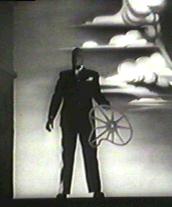Spellbound
  
Spellbound begins at Green Manors, a "home" for those in need of psychoanalysis. Here, doctors like Constance Peterson (Bergman) seem able to diagnose instantly even the most complex psychosis on the basis of a few words from the patient. These doctors wield words like "guilt complex" and "dream interpretation" about like shining swords, presumably cutting through the diseased thoughts of their patients and "opening the doorways of the mind" to expose the truth. Those who seem particularly good at these techniques, like Peterson, do so at the expense of their own emotions. Early in the film, a colleague of Peterson's tells her that her "lack of human emotion" is the only thing holding her back from being a truly great psychoanalyst. Human emotion arrives in the form of Dr. Anthony Edwardes, a dashing young psychiatrist who has come to assume the directorship of Green Manors. It's love at first sight for a woman who scorns the idea of love. It's no wonder she becomes so entirely devoted to him, if he can inspire these feelings in her. But soon we understand that all is not as it seems. Edwardes reacts strangely to certain patterns and situations, and Peterson quickly deduces that Edwardes is not Edwardes at all -- indeed, he may be Edwardes' killer. The man she loves is stricken with amnesia and only knows his initials -- J.B. He has taken Edwardes' place because he doesn't know what else to do. However, Peterson's love for the man convinces her that he could not possibly be a murderer, and she helps him to escape the authorities who have been alerted to the fact that Edwardes is not what he seems. While they are on the run, Peterson tries to dig through J.B.'s psyche to discover the cause of his amnesia and fears. They end up hiding in the house of Constance's old mentor, Dr. Brulov, telling Brulov they are on their honeymoon. Brulov, welcoming the "newlyweds" into his house late one evening, bids them "Good night and happy dreams -- which we will analyze at breakfast." That's exactly what happens. Spellbound is really a showpiece for Bergman, who is on camera nearly every second of the film's 111 minutes. Though Bergman's screen presence cannot be denied, it is odd to see her so cold and detached at the beginning of the film. We are much more comfortable seeing her in the role of weepy, emotional girlfriend, similar to her role as Ilsa Lund in Casablanca. Peterson's shifts between the arrogant psychoanalyst and the shaky, concerned lover make it look like she's the one in need of psychiatric help.
There are two scenes in particular within Spellbound which are worth mentioning. The first is the renowned dream sequence, designed by Salvador Dali. Reportedly, it was cut to a fraction of its original length -- alas, we didn't get to see Ingrid Bergman covered with ants. Eeeyuh -- that's just as well, in our opinion. It's nice to see, however, that the dream sequence actually makes some sense by the end of the film; its original interpretation is somewhat simplistic. The second is that magical moment of realization when Constance finally realizes the complete truth about JB and Dr Edwardes. It's a Hitchcock trademark scene, in which everything rushes together at the end of the film and the mystery is finally resolved in an explosive fashion. These scenes, in which the final piece of the puzzle falls into place, are the ones for which he will be remembered. As Spellbound comes to its conclusion, we get the feeling that Hitchcock doesn't like psychoanalysts very much, but he realizes that there may be some validity to their work. Certainly, he doesn't paint an attractive portrait of the practitioners, but they do manage to get results by the end of the story. The same could be said for the film itself: there are sequences which are downright silly (watch Ingrid Bergman pretend to ski down a mountainside). These silly moments, however, do not stop a rather chilling tale from reaching the viewer. Spellbound is not Hitchcock's best work; it didn't do for wrought iron fences what Psycho did for showers. But it is unmistakably his -- and even Hitchcock's worst work is head and shoulders above the best films of most other directors.
 Review date: 7/30/97 
This review is © copyright 1997 Chris Holland & Scott Hamilton. Blah blah blah. Please don't claim that it's yours blah blah, but feel free to e-mail it to friends, or better yet, send them the URL. To reproduce this review in another form, please contact us at guys@stomptokyo.com. Blah blah blah blah. |

